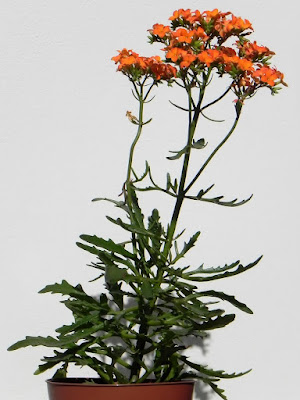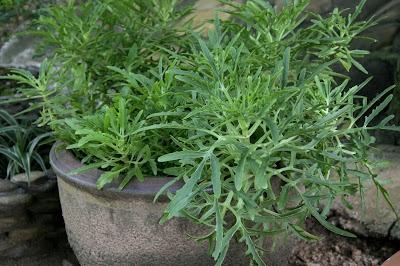Kalanchoe laciniata, also called as Christmas tree plant, Cathedral bells is found growing in rocky grassland, open bushland, scrub, margins of...
Kalanchoe laciniata, also called as Christmas tree plant, Cathedral bells, Cotyledon laciniata, Kalanchoe angustifolia, Kalanchoe biternata, Kalanchoe carnea, Kalanchoe gloveri, Kalanchoe lentiginosa, Kalanchoe petitiaesii, Kalanchoe rohlfsii, Kalanchoe rosea, Kalanchoe rosea, Kalanchoe schweinfurthii, Kalanchoe teretifolia, Vereia laciniata, is a species of the genus Kalanchoe. This species was described by Augustin Pyramus de Candolle in 1802.
IDENTIFY KALANCHOE LACINIATA - CHRISTMAS TREE PLANT - CATHEDRAL BELLS
Kalanchoe laciniata is native to Eritrea to Northwestern Namibia, Arabian Peninsula. It is found growing in rocky grassland, open bushland, scrub, margins of thickets, on stony ground, rocky slopes and ledges, in shady situations, sandy or humus-rich soil at elevations of 450-2100 metres above sea level.
It is a short-lived perennial, or possibly sometimes biennial which reaching 0.1-1.5 meters in height with erect, simple, terete, smooth, reddish, leafless at fruiting time stems. The fleshy stem is usually unbranched, it dies back to a large, underground tuber in dry conditions. The succulent leaves are petiolate, usually compound or dissected, glabrous, pale to dark green on drying.
Christmas tree plant blooms in early summer to late summer from the up to 40 cm long, flat-topped, finely and densely glandular-pubescent inflorescences with flowers in dense cymes. The flowers are greenish-white to light orange in colour and grow up to 15 cm long.
KALANCHOE LACINIATA - CHRISTMAS TREE PLANT - CATHEDRAL BELLS CARE AND CULTURE
Cultural information should only be used as a guide, and should be to be adapted to suit you. Your physical location; where you grow your plants, how much time you have to devote to their care, and many other factors, will need to be taken into account. Only then can you decide on the cultural methods that best suit you and your plants.
Light:
Kalanchoe laciniata can grow in full to partial sun, a southern, eastern or western exposure. During summer do not allow direct sunlight because its leaves who contain lots of water will get sun-burned. Direct sunlight from fall till early spring will not harm your plant.
They are short-day plants, and by manipulating the length of the day and night, growers can have plants flowering at any time of the year, much like Chrysanthemum species. Long days (10 -14 hours of uninterrupted darkness per day) are given in the beginning of the culture (before the visible of the buds) to promote rooting and vegetative growth. Short days are given in the rest of the culture to promote flowering. They tend to bloom more from fall till early spring the reason being that days are shorter during these months.
Temperature:
Christmas tree plant grow best at the optimum temperatures range between 64 and 68 °F (18 and 20 °C) day and night. If temperatures are under 61 °F (16 °C) day and night, this can delay plant growth and development and may cause blind eyes or no flowering. It is very sensitive to cold and it takes only a few hours of near 40 °F (4 °C) for the plant to die. Avoid placing it near drafts or cool windowsills.
Substrate and growing media:
Kalanchoe laciniata can be grown in 2.5-inches, 4-inches or 6-inches pots with the rooting media and subsequent growing media that are fast draining and high in organic matter. Their root system is extremely sensitive and it would be advisable to use clay pots that allow better aeration of the roots. Ensure excellent drainage by placing pebbles at the bottom of the pot and use light soil containing lots of peat moss, perlite and sand.
The plants love to be alone in small pots. However, the larger the pot the larger the leaves but the size of the top will hardly affect blooming or rate of growth. Avoid planting companion plants in the same pot and repot each spring adding fresh soil.
The pH is also critical and should be in the 6.0 to 6.5 range. The plants are sensitive to zinc deficiency, which can be aggravated by high phosphorous. But at this pH range, both zinc and phosphorous should be available at suitable levels. They also have high calcium requirements.
Watering:
Christmas tree plant like water only when the top level of their soil is dry. Wet soil should be avoided. The most common mistake people make is overwatering which can cause the roots to rot. You can easily prevent this by allowing your plant to dry out completely before watering. The foliage should be kept as dry as possible and, therefore, using a system, such as drip irrigation, is best.
Fertilizer:
Fertilize the plants with ratio 3:1:3 (N:P:K) until bud formation. During the flowering period, the ratio should change to 2:1:4 or 3:1:4. It may be necessary to make supplemental applications of major elements, including calcium and magnesium and trace elements, particularly iron and manganese.
Pruning:
Little or no pruning is necessary for many years. If needed, pruning should be done immediately after flowering. When pruning, simply pinch or clip them back where they attach to the stem. Pinch out dead flowers regularly to stimulate new flowers to form.
Many of the new cultivars have good basal branching, so no pinching is required, which was a very labor-intensive project necessary with the older cultivars. However, if a cultivar requires pinching to encourage branching, today the plants are normally treated with growth regulators.
Rest period:
When the flowers start to die back, cut them off and let the plant rest. After deadheading, you should reduce watering as the plant will need less water during this resting period. Soon you will notice new buds and your plant will bloom again. This change in blooming and resting cycles will go on throughout the year irrelevant to seasons.
Pests and diseases:
Kalanchoe laciniata are resistant to disease and insects but if kept outdoors, could eventually be affected by aphids, scale, spider mites and nematodes. Common symptoms include apart from insects themselves on the crossing of the stems or the undersides of leaves, the presence of honeydew on leaves, creased faded leaves and webs, or leaves that look torn or bitten. Prefer non-toxic treatments because the plants are very sensitive to certain ingredients used largely in insecticides widely used. If you decide to buy a chemical insecticide do tell the nursery that you are planning to use it on a plant.
Propagation:
Cathedral bells is usually propagated by cuttings. Cuttings normally root in about three weeks during the summer months and four to six weeks in the winter at temperatures of 70 to 74 °F (21 to 23 °C). Using bottom heat may increase rooting speed.















COMMENTS